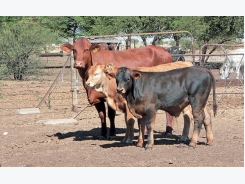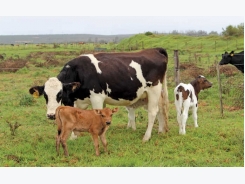The value of instant green feed as livestock fodder

Germinated grain produced in a closed system is a highly nutritious fodder, but factors such as the high cost of production and the high moisture content may make it uneconomical, says Prof Tertius Brand.
Closed system fodder production makes efficient use of water and requires considerably less land to produce feed for livestock. Photo: Courtesy of Prof Tertius Brand
Growing green feed from grain seed such as barley, oats, wheat and maize in a closed system dates back to the 1930s. Lately, due to the high cost of feed and land, there is renewed interest in this type of fodder. Closed-system fodder production makes efficient use of water and reduces the area of land required to produce feed for livestock. As it is a closed, controlled system, forage can be produced year-round.
But according to an article by Prof Tertius (Ters) Brand from the Directorate of Animal Sciences at the Western Cape agriculture department at Elsenburg and the Department of Animal Sciences at Stellenbosch University, while it yields excellent feed, disadvantages of the system and the feed it produces suggest it should be used only as a supplement.
How it works
In closed fodder production systems, seed is soaked for a few hours or overnight and then spread over plastic or metal growing trays. During the growing period, drip or spray irrigation supplies moisture. Holes in the base of the trays facilitate drainage. The grain seed sprouts are removed after about a week for livestock fodder.
“The system is closed and only water is added,” Brand explains. He adds that in these systems, where no plant nutrient or fertiliser is added, no increase in protein or nitrogen can occur. This contrasts with plants grown in soil, which obtain their nitrogen and other nutrients from the soil (or fertiliser) or with legumes where nitrogen is fixed by rhizobium bacteria.
“In the instant grain-feed system, the total amount of protein in the seed before germination equals the total amount of protein after germination,” he explains. Changes in the nutrients in the grains do occur. Starches are converted into sugars and fibres (in the cell walls) during the germination process and specific vitamins accumulate during the growth process.
According to Brand, experts agree that an increase in dry material in such a short period is improbable and that a loss in dry material does, in fact, occur instead (see table).
Nutritional Value
To understand the possible change in the nutritional value of the grain, one has to understand what occurs during the germination process, Brand says. Moisture and enzyme activity increases. The enzymes then break starches down into sugars, proteins into amino acids and fats into fatty acids. The relevant amount of fibre in cell walls – cellulose and hemicellulose – also increases, vitamins are synthesised, and certain anti-nutrient factors are destroyed. All this requires energy, which is obtained principally from the starch in the seed.
This explains the decrease in the starch and dry material and the net loss in the energy of the end-product (the green feed).
“Experts agree that the contribution of photosynthesis in the formation of nutrients over such a short period is minimal.”
According to Brand, in work done at Elsenburg the starch content of instant feed barley decreased from approximately 47% in the kernels to 16,5% in the germinated grain. The starch fraction is converted into sugar and crude fibre during germination.
In addition, the non-protein nitrogen content of the germinated barley was 1,06% (equal to 6,25% of protein). The crude-fibre content of the germinated barley increased from 6,1% to 16,9%, with a consequent decrease in in vitro digestibility of 22,5% when barley sprouted into green feed. “It is important to remember that the moisture or water content of green feed is very high (approximately 85%) in comparison with that of grain (approximately 10%),” writes Brand.
The seven to eightfold increase in the mass of the green feed is therefore an increase in moisture level, while the increase in other nutrients such as protein and fat is on a percentage basis, but remains unchanged on an absolute yield base as a result of the loss in starch and dry material in the grain, he explains. It should be noted that when the loss in dry material during germination is taken into account, the amounts of these nutrients remain constant.
Pros and cons
Brand stresses that these findings are supported by most researchers, who have reported a considerable loss in dry material and energy, a minimal change in protein and a large increase in crude fibre. Thomas and Reddy (1962), for example, tested and calculated the total input: output ratio in germinated oats green feed with that of the original grain in an instant grain-feed system.
Brand says they reported that after the germination of the grain into green feed, 75% digestible dry material, 82% digestible energy, 90% digestible protein, 77% total digestible nutrients and 323% crude fibre remained of the original material.
Researchers have found, however, that the content of certain vitamins, such as vitamins A and E, biotin and folic acid, increased seven to eightfold. But Brand says in ruminant diets such as in cattle and sheep, certain vitamins that can meet a large part of their requirements are also manufactured by micro-organisms in the rumens of the animals.
According to an MSc study by Horn in 1983 at the then University of the Orange Free State, an energy loss of about 15% occurred during germination in maize. Although the study showed a dry-material gain, instant grain feeding suppressed the fodder intake of lambs in comparison with the intake of the grain on its own. Lambs fed crushed maize and instant (maize) grain feed also showed weaker growth.
Brand refers to a 2003 study titled ‘Review of Hydroponic Fodder Production for Beef Cattle’, by Roger Sneath and Felicity McIntosh, which reports that animal performance can decrease if livestock are fed mouldy sprouts. In severe cases, it can result in death. The study was published by Meat & Livestock Australia (MLA), a producer-owned company providing research to livestock farmers in Australia.
According to Sneath and McIntosh, good hygiene in the system and pre-treating seed with a sterilising agent such as hydrogen peroxide can help prevent mould. The report recommends that growing trays be cleaned regularly with a chlorine- based cleaning solution.
“Fungal growth will remain one of the biggest problems in the cultivation systems of green feed, since fungal spores are present on most grain crops and the systems themselves provide ideal conditions for fungal growth,” says Brand.
Uneconomical
According to Brand, the Australian researchers also discovered that the economic use of germinated grain for green feed in beef-cattle production was unlikely. “They found that although germinated grain was a highly nutritious source of fodder, the high cost of production, the scale of production required, the high moisture content and the risk of fungal growth did not make it worthwhile,” he says.
For example, the production cost of 1kg of instant grain feed was two to five times that of 1kg of the original grain.
Instant grain feed could well be used in small-scale farming as a source of vitamins for monogastric animals, but not for feeding systems on commercial farms, says Brand.
He points out that in 1962 Thomas and Reddy had already found that the cost of 1kg of total digestible nutrients in germinated grain, after accounting for input costs, amounted to 400% of that of 1kg of total digestible nutrients in the original grain. “The principle of placing 1kg of dry grain in a closed system and harvesting 7kg of green feed appears very attractive,” says Brand.
Có thể bạn quan tâm
Phần mềm

Phối trộn thức ăn chăn nuôi

Pha dung dịch thủy canh

Định mức cho tôm ăn

Phối trộn phân bón NPK

Xác định tỷ lệ tôm sống

Chuyển đổi đơn vị phân bón

Xác định công suất sục khí

Chuyển đổi đơn vị tôm

Tính diện tích nhà kính

Tính thể tích ao hồ



 Breeding Brahman cattle with superior genetics
Breeding Brahman cattle with superior genetics  Bovine respiratory disease complex
Bovine respiratory disease complex